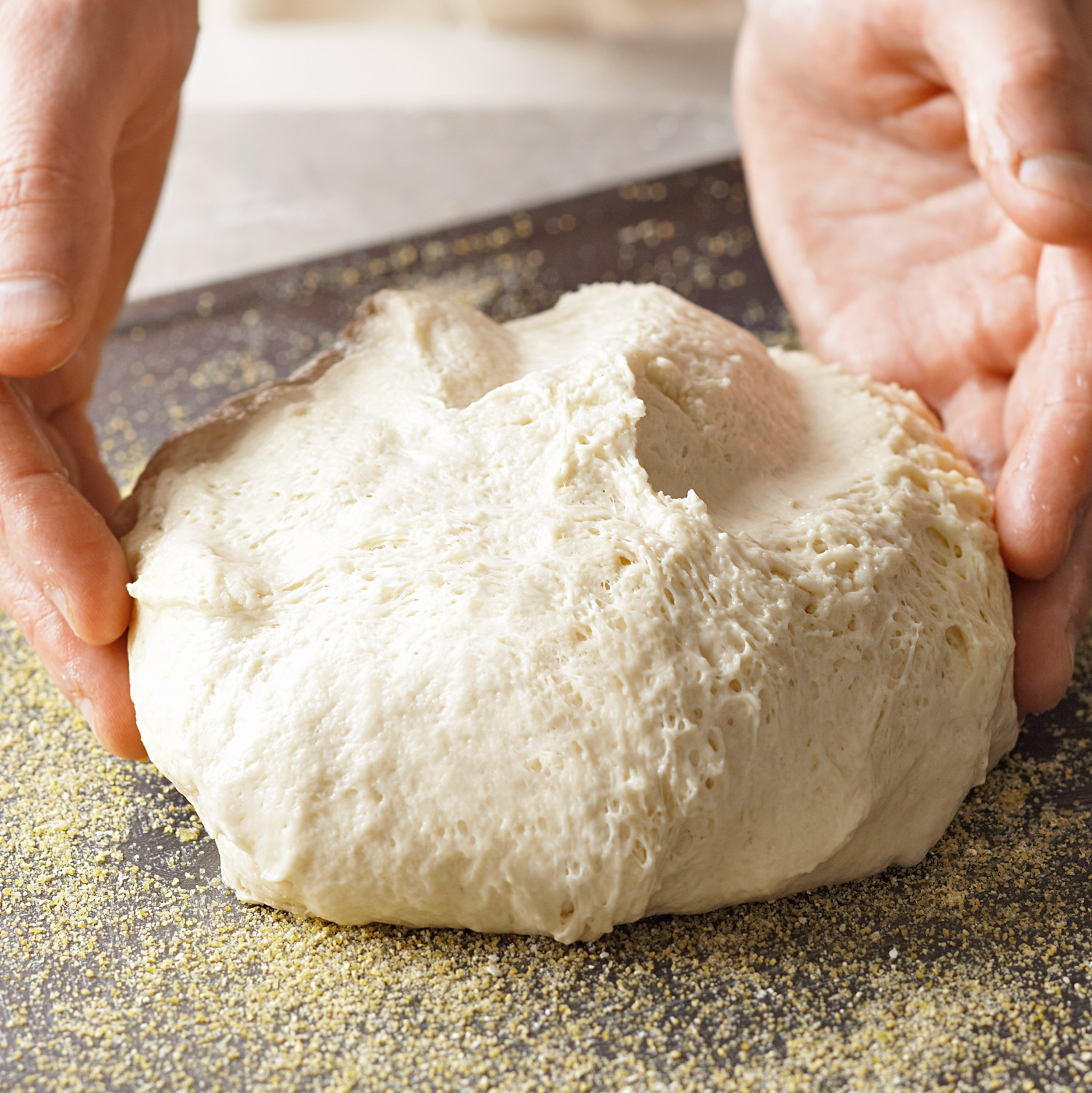MAKES: 12 servings TESTED BY: Juli H.
073 Artisan Bread
TASTING COMMENTS:
Most artisan-style breads require kneading to develop the gluten strands that give them their characteristic tuggy texture. We discovered that a long fermentation time—up to 24 hours—has the same effect. No kneading required!—JH
prep 25 minutes chill 4 hourS stand 30 minutes rise 1 hour bake 25 minutes at 400°F
- ¾ cup warm water (105°F to 115°F)
- 1 pkg. active dry yeast
- ½ cup milk
- 2 Tbsp. sugar
- 2 Tbsp. butter or olive oil
- 1½ tsp. salt
- 2¾ cups all-purpose flour
- Nonstick cooking spray or olive oil
- Cornmeal
- 1 egg
- 2 tsp. water
Active dry yeast feeds on sugar in dough to make carbon dioxide. It works slowly and develops flavor in dough as the bread rises. Store any opened yeast in the refrigerator and use before the expiration date.
Salt adds flavor to bread and creates a stronger dough, but too much can inhibit yeast from doing its job.
1. In a large bowl stir together the ¾ cup water and the yeast. Let stand 5 minutes. Meanwhile, in a small saucepan heat and stir milk, sugar, butter, and salt just until warm (120°F to 130°F) and butter, if using, almost melts. Stir milk mixture into yeast mixture until combined. Stir in flour (dough will be sticky). Place dough in a lightly greased bowl; turning to grease surface of dough. Cover and chill 4 to 24 hours.
2. Turn dough out onto a floured surface. Cover with greased plastic wrap. Let stand 30 minutes.
3. Lightly grease a baking sheet; sprinkle with cornmeal. Gently shape dough into a 6-inch round loaf. Place on the prepared baking sheet. Cover; let rise in a warm place until nearly double in size (about 1 hour).
4. Preheat oven to 400°F. In a bowl whisk together egg and the 2 tsp. water; brush over loaf. Bake 25 minutes or until bread sounds hollow when lightly tapped. (An instant-read thermometer should register at least 200°F when inserted in center of loaf.) If necessary, cover loosely with foil the last 5 minutes of baking to prevent overbrowning. Immediately remove from baking sheet; cool on a wire rack.
Per serving 199 cal., 7 g fat (3 g sat. fat), 29 mg chol., 469 mg sodium, 27 g carb., 2 g fiber, 3 g sugars, 7 g pro.

Artisan Rolls Prepare as directed, except shape dough into an 8-inch square. Cut into sixteen 2-inch squares, flouring the dough and knife as necessary. Place about 1 inch apart on a baking sheet. Bake about 15 minutes.
Stir-Ins In Step 1, add any of these stir-ins in when you add the milk mixture to the yeast mixture.
smoked gouda-bacon ½ cup ground toasted almonds, ½ cup shredded smoked Gouda cheese (2 oz.), ¼ cup crisp-cooked and crumbled bacon, ¼ cup stone- ground mustard, and 2 tsp. toasted caraway seed
rhubarb-raisin 1 cup chopped fresh or frozen rhubarb, ½ cup golden raisins, 2 Tbsp. finely chopped shallot (1 medium), 2 tsp. grated fresh ginger, and ½ tsp. ground coriander
sweet potato ½ cup cooked mashed sweet potato and ½ tsp. pumpkin spice; reduce water in Step 1 to ½ cup
cheese-olive ½ cup crumbled feta cheese (2 oz.); ½ cup grated Asiago cheese (2 oz.); ¼ cup chopped pitted Kalamata olives; ¼ cup thawed and well-drained chopped spinach; and 4 cloves garlic, minced
apricot-swiss ½ cup cooked chopped onion, ½ cup finely snipped dried apricots, ½ cup shredded Swiss cheese (2 oz.), and 1 tsp. snipped fresh sage
TESTING NOTES
1. This bread relies 100 percent on your yeast, so use a reliable instant-read thermometer to check the temperature of the water. It should be between 105°F and 115°F. Just as important, keep your milk mixture below 130°F before adding it to the yeast.
2. While the dough chills, magical things are happening. The yeast is working slowly, leavening the dough and altering the protein in the flour to allow for a more open, tuggier crumb and a tangy, yeasty flavor.

3. After chilling, use a dough scraper or rubber spatula to carefully and gently transfer the dough from the bowl, trying not to disturb the spongy texture. The dough will be sticky, but add as little excess flour as possible when you handle it.

4. Use wet hands and a little flour to help gently shape the dough before placing it on a cornmeal-covered baking sheet.
